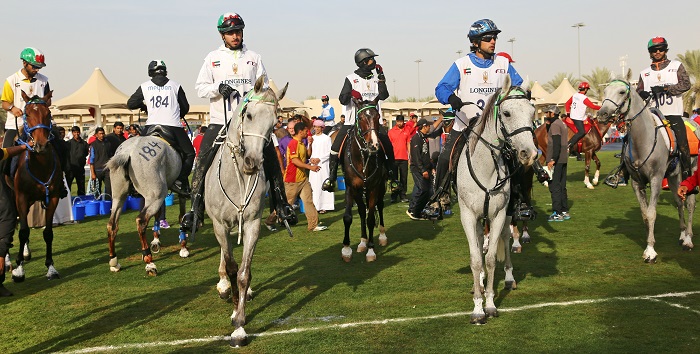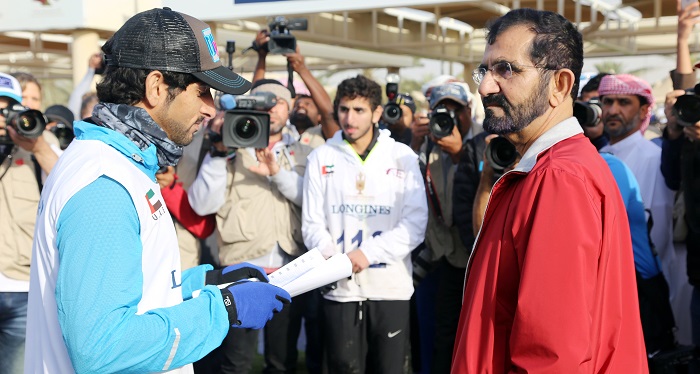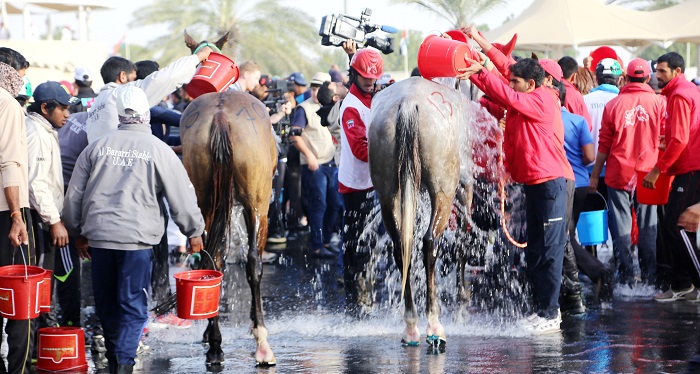Words By: Cindy Stadelmann & Cosmo
In the last edition, we gave you some insights into hacking in and around Al Khawaneej. What a great way to exercise. I, Cosmo, love to have a blast out in the desert but as I mentioned last month, I do encounter other horses and riders there who are training hard for endurance races and they take “riding through the desert to the next level”.
Endurance riding is very popular amongst UAE nationals and even His Highness Sheikh Mohammed bin Zayed Al Maktoum and his sons participate in Endurance events nationally and internationally. It is absolutely fascinating to watch this sport. The first endurance races were done in the USA and organised events were registered in 1955. In 1998, the UAE was the second country to host the World Championship. But before setting up a world event, the UAE under the directive of President His Highness Sheikh Zayed bin Sultan Al Nahyan organised its first distance events in 1993. In this 40km race, camels competed against horses in the dunes of Dubai and the first 15 places were taken by horses. In 2014, in the UAE, endurance riding was tied into modern triathlons and substituted the normal swim: horse-ride, cycle, run = The Dubai Desert Triathlon. Two competitions have taken place since and were very popular.
What is an endurance race?

In one sentence, endurance races are competitions in which horse and riders cover very long distances at the highest speed possible. The distances vary from 80km (in one day) to 240km (over up to three days). The terrain in the UAE is certainly desert but in other countries the riders compete through forest trails, fields, etc. Any horse type can participate, but Arabians are dominating the scene due to their superior stamina. In order to participate, horses and riders need to first participate in speed-regulated “Qualifiers”. They need to successfully complete two rides with the distance of 40km and two rides of 80km. Minimum age for these qualifiers is five years for the horse and 14 years for the rider. In qualifier races there is no weight restriction, but for the official races there is. No whips and spurs or other special riding aids are allowed during endurance races. Your legs and reins are the only tools to indicate to your horse to go faster or slow down.
In order to regulate the speed for these qualifier races a car drives at the head of the group and acts as pacer. Nobody is allowed to pass this car. The goal of qualifiers is to finish the “race” comfortably and as fast as possible, within the given time limit. The distance to cover in any of these races is not completed in one section but rather legs or phases (indicated with different flag colours along the path) of different distances. All loops start and finish at one central location. Here all rider and teams set up their “camps”, depositing all tools and equipment they might need throughout the day. The equipment that I am referring to includes riding tack, sunscreen, water and feed for horse and rider, big buckets with ice-water, heart rate monitors, helmet, chaps, bandana and clothes for the rider. The format for qualifiers and official races is more or less the same.
Registration and checking
The day before the race riders need to register and the horses need to be brought to the host of the endurance cup and presented to the vets. It starts with “trotting the horse up” in front of a vet to assess potential lameness, which means the rider runs next to the horse on a track of around 20m, first away from the vet and then back towards the vet. If the horse is judged as lame, the race ends there. The vets also check the horses’ passports to ensure that the horse in the passport is identical with the horse they see and the vaccination cycles are validated. The vets also measure the heart rate (around 36-42/bpm), breathing, and evaluate the hydration level. For the latter the vet checks that the eyes are shiny, the skin is elastic (pinching the skin on the horse’s neck) and presses his or her finger against the horse’s gums. The gums will turn white or light pink for a moment. If the gums turn normal again in less than three seconds the horse is sufficiently hydrated. All details are recorded on a form. If the horse passes, the registration number of the horse/rider team is drawn onto the horse’s hind with a big marker (quite tricky if you have a dark horse). It is admitted to the race. After the check, the rider can either bring the horse back to its stable if it is close or leave the horse under groom supervision in temporary stables close to the facility. The impressive Dubai International Endurance City in the Bab Al Shams area is a great example. I can highly recommend doing a quick drive there when a race is on. You will not believe your eyes when you enter the facility. Lush grass, a state-of-the-art facility, and lots of organised hustle and bustle. Entry is free and you often encounter royals strolling around and working with their teams.

Since the races start early in the morning, many riders camp, sleep in their cars or stay in bedrooms that some endurance facilities offer. The next morning the riders get ready, put on their race number and assemble at the exit gate. They all leave together and trot or canter to complete their first loop. Each rider chooses their own pace. On the way, vets in cars accompany the riders on tracks next to the riding path. They flag riders down if a horse is spotted and assessed to be unfit to continue. Important to mention is that the drivers always drive on the off wind side to avoid dust and dirt polluting the air around the competitors.
The race
Throughout the event the race organisers have a few horse trailers stationed in case the horse cannot move any further and needs to be transported back to the centre. Also at numerous places are dedicated areas where horses can drink out of buckets or endurance team members hand riders water bottles from which they can drink or pour over the horse to cool it down while it is on the move. Some horses are initially quite sensitive about having their rider hold a bottle over their neck and suddenly splashing water over them. “Something over my head is making a slushy noise over my head.” Scary! It takes practice and time for the horses to get acquainted with these techniques. Once horse and rider return through the entry-gate, their time is stopped. Now the horse has to cool down and its heart rate has to slow down to less than 60bpm to be then presented to the vets again. The saddles and bridles are taken off. In headcollars they are gently walked around and buckets of iced water are poured over the horses’ bodies to bring the heart rate down. Once that is accomplished, you line up for the vet check. The vets review the existing record of the horse and assess the data again. Any lameness, dehydration or other health problems are factors to declare the horse as “unfit”. After the vet inspection, the horse is held for another 20 to up to 45 minutes for a break to eat and drink before the horse continues on the next leg. The riders also take in their nutrition and stretch. Needless to say that the time out on the tracks and inside the centre is electronically monitored. After this break, each individual horse and rider leave the exit-gate at a time depending on their “entry” time and time they had to stay and rest. Depending on the length of the race, the competitors complete two or more legs every time repeating the vet inspection and break. The winner of the race is the first team to come back from the entire race length and pass a final vet check.
Training and preparation

To accomplish these races, horse and rider have to put a lot of time into training and start preparing months before the race season, similar to human athletes training for ultramarathons, Ironmans and other races. Numerous days per week they go out, mostly in bigger groups, and improve their fitness levels and stamina.
Besides Dubai International Endurance City, there are two other self-sufficient modern endurance centres or villages in the UAE. At this point, 22 riding clubs and equestrian establishments are registered with the Emirates Equestrian Federation. Some of the races are women only. To have a look at the scheduled events go to the “Endurance” schedule at www.eef.ae.
Anyway, enough chat, it’s time to get outside and log some more kilometres in the desert. Stamina doesn’t come by standing and gossiping.
Another great way of spending hours outside with your horse and similar to the human “triathlon” is participating in eventing competitions, formerly known as Military. In the next edition of the magazine, we will share with you details on this great discipline.

